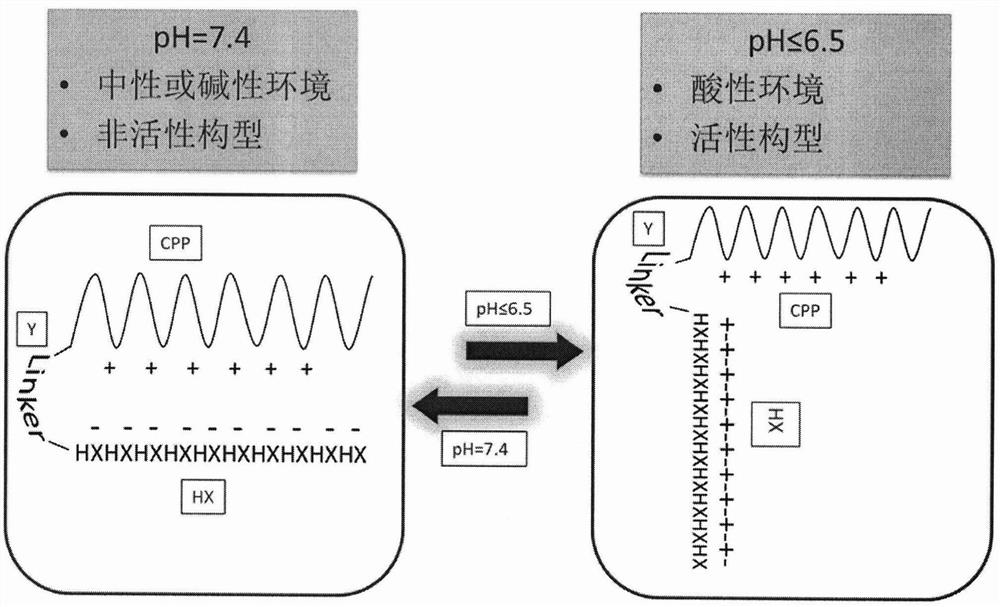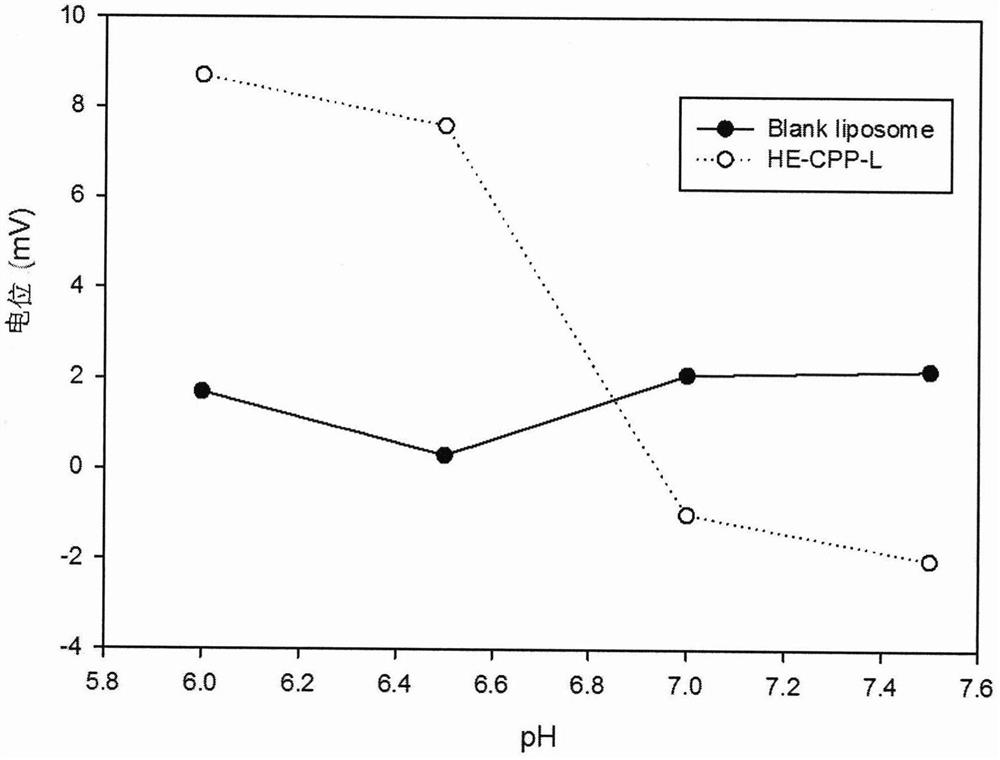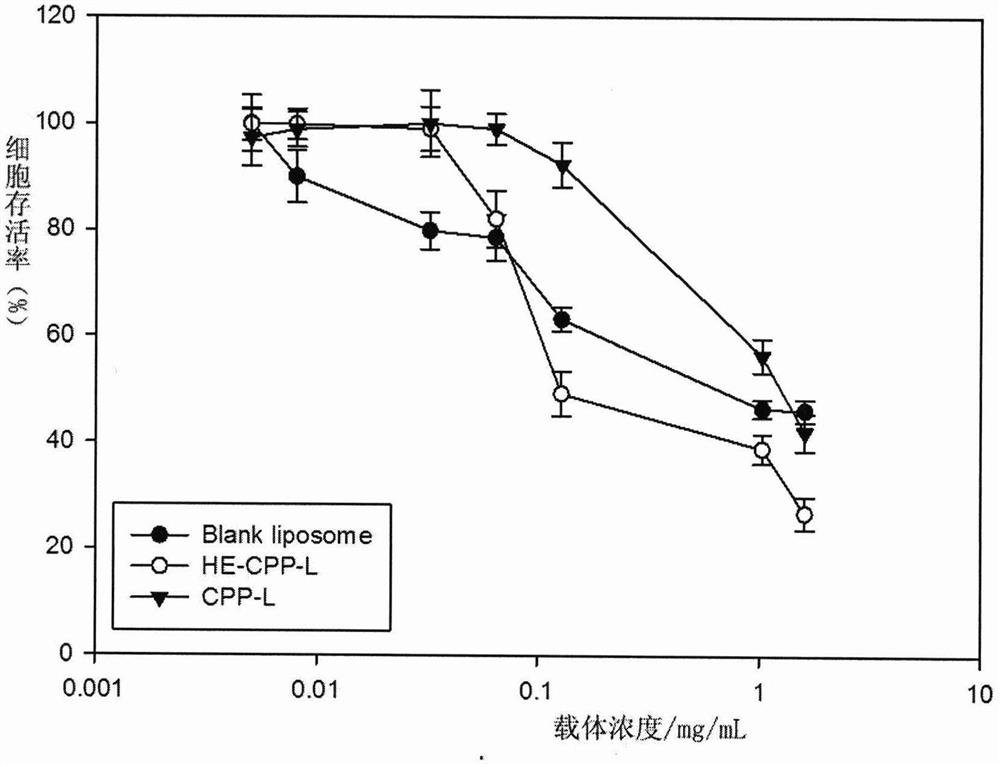A kind of pH sensitive polypeptide and its application
A sensitive and polypeptide modification technology, applied to polypeptides, peptides, and hybrid peptides containing positioning/targeting motifs, can solve the problems of lack of specificity and limit the application of CPPs in vivo, so as to reduce absorption and increase active The effect of targeted effects
- Summary
- Abstract
- Description
- Claims
- Application Information
AI Technical Summary
Problems solved by technology
Method used
Image
Examples
Embodiment 1
[0046] Synthesis of HE-CPP-PEG-DSPE
[0047] Weigh 5.6mg Mal-PEG-DSPE (Fanshuo Biotechnology Co., Ltd., B06012) into a 1.5mL EP tube, add 1mL DMF to dissolve, add 9mg HE-CPP to dissolve and shake to make it evenly dispersed, adjust the pH with triethylamine to 7.0. The reaction tube was flushed with nitrogen to protect the seal, and the reaction was shaken at 37°C for 24h. Evaporate the organic solvent DMF on a rotary evaporator, place in a desiccator to vacuum for 4 hours, add 1.5 mL of aqueous solution to hydrate, and freeze-dry for storage.
[0048] Equimolar concentrations of the products before and after the reaction were prepared respectively. Take a 96-well plate, add 100 μL of sample to each well, then add 100 μL of 1 mM DTNB solution, detect with a microplate reader at 450 nm, and calculate the reaction efficiency by detecting the residual amount of sulfhydryl groups by Ellman test. The yield of HE-CPP-PEG-DSPE was 55.04%.
[0049] Preparation of HE-CPP modified li...
Embodiment 2
[0053] Synthesis of CPP-PEG-DSPE
[0054] Weigh 5.6 mg of Mal-PEG-DSPE into a 1.5 mL EP tube, add 1 mL of DMF to dissolve, add 2.5 mg of R6 to dissolve and mix well, and the rest of the operations are the same as in Example 1.
[0055] The synthesis yield was detected by the method of Example 1, and the yield of CPP-PEG-DSPE was 89.62%.
[0056] Preparation of CPP-modified liposomes
[0057] Weigh 120mg of SPC, 20mg of CH, 10.46mg of CPP-PEG-DSPE and completely dissolve in chloroform, transfer to a 250mL eggplant-shaped bottle, rotate and evaporate chloroform at 40°C, spread a uniform monolayer film, and place in a desiccator vacuum overnight. Add 5 mL of distilled water to hydrate the lipid monolayer membrane, shake it to make it into a primary liposome, sonicate the probe for 5 minutes, 200W, and pass the prepared blue opalescent solution through a 0.22 μm filter membrane to obtain CPP modified with uniform particle size liposomes, namely CPP-L. The particle size of the ...
PUM
| Property | Measurement | Unit |
|---|---|---|
| particle diameter | aaaaa | aaaaa |
| particle diameter | aaaaa | aaaaa |
Abstract
Description
Claims
Application Information
 Login to View More
Login to View More - R&D
- Intellectual Property
- Life Sciences
- Materials
- Tech Scout
- Unparalleled Data Quality
- Higher Quality Content
- 60% Fewer Hallucinations
Browse by: Latest US Patents, China's latest patents, Technical Efficacy Thesaurus, Application Domain, Technology Topic, Popular Technical Reports.
© 2025 PatSnap. All rights reserved.Legal|Privacy policy|Modern Slavery Act Transparency Statement|Sitemap|About US| Contact US: help@patsnap.com



